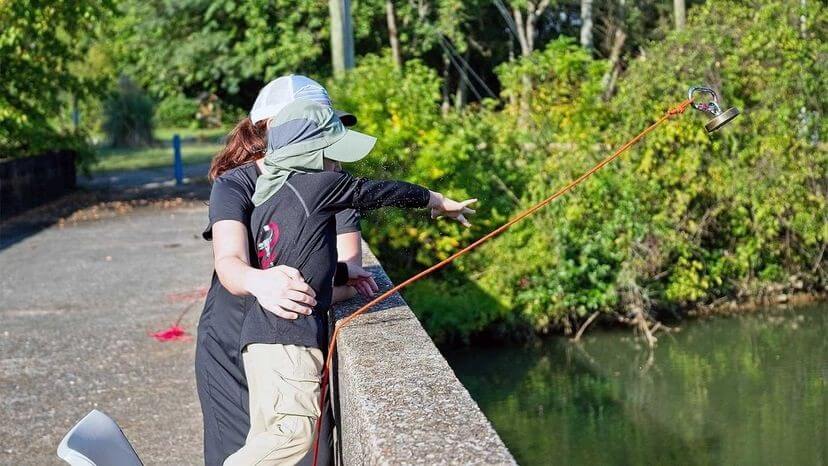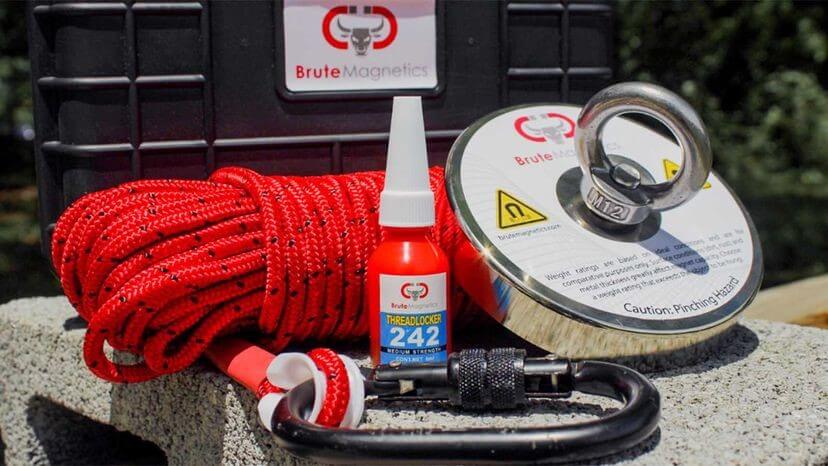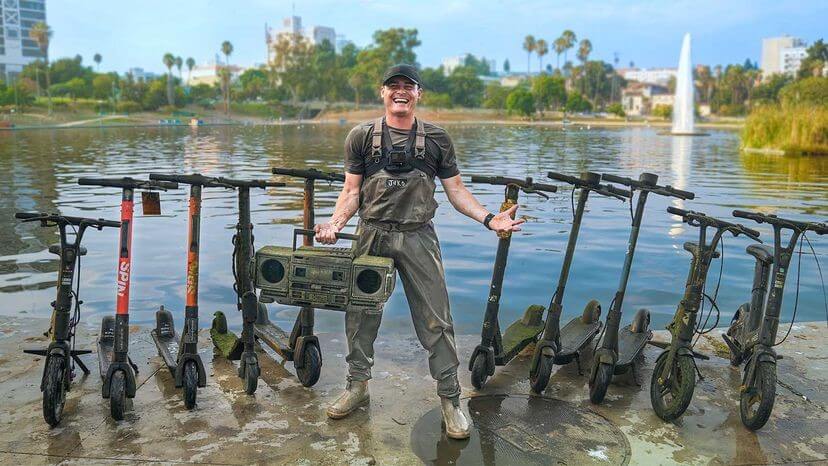
What’s Attracting So Many People To Magnet Fishing?
Magnet fishing is easy, safe and fun for kids and adults. It's also good for the environment.
By: Alia Hoyt & Allison Troutner | How Stuff Works
The magnet fishing of our youth, like the game “Let’s Go Fishin” that featured miniature plastic rods to “hook” fish via tiny magnets, just got a major upgrade. Today, magnet fishing hobbyists use rope and mega-strong magnets to pull trash, firearms, bicycles and even Civil War artifacts from their local waterways.
But in Europe, authorities aren’t so fond of magnet fishing. From Berlin to Edinburgh, there are reports of magnet fishers leaving their rusty refuse on walking paths next to canals. The trash they pull from the waters stains sidewalks and causes pedestrian hazards. Even worse, magnet fishers are retrieving forgotten World War II grenades; police worry that magnet fishing may, quite literally, blow up.
So is magnet fishing a win-win for cities or more of a nuisance?
What Is Magnet Fishing?
Anybody can start magnet fishing. All you need is a strong magnet, rope and a bit of patience. You just throw your rope into the water and pull in whatever your magnet attracts. It’s a lot like fishing, except instead of a bass or bluegill fish, you might reel in a gun or two, like the grandfather-grandson duo, who in late January 2022, hauled up what appeared to be two sniper rifles wrapped in shrink wrap from a canal in their Miami, Florida, suburb.
Magnet fishing is not a new hobby, but its popularity skyrocketed in 2021 when hobbyists started sharing news of their treasure hunts on platforms like YouTube, which has more than 539,000 videos related to the topic.
Clay Copeland, founder and president of Brute Magnetics in North Georgia, says he grew up loving treasure hunting and metal detecting. Around 2013, Copeland learned that his father used to go magnet fishing in the 1960s. So Copeland took his dad’s old military surplus magnet and thought he’d give it a go. His magnet immediately got stuck in the weeds.
“I started thinking, this is a neat hobby, but there was no market for it,” Copeland says. “There were no products that were geared toward [magnet fishing] specifically.”

A Magnet for Everyone
So in 2016, Copeland founded Brute Magnetics to provide magnet fishing hobbyists specialized equipment. Over the past two years, the business has seen a spike in sales.
“It really kicked up when the pandemic hit, and there were [lockdown] restrictions,” Copeland says. “Magnet fishing is a great hobby for that. You can get outdoors, social distance and clean up the waterways. Maybe you’ll find something interesting.”
For those looking to get outside and social distance from others, magnet fishing became an ideal hobby.
Today, magnets are available in a range of strengths and shapes geared specifically for magnet fishing hobbyists of all levels and any environment. “We have everything from a junior magnet that pulls about 400 pounds [181 kilograms], up to the serious level, magnets that can pull over 2,000 pounds [907 kilograms],” Copeland says.
Brute Magnetics magnets are made from neodymium; your typical fridge magnet is made from ferrite. “Neodymium is a rare Earth metal that’s mixed with boron and iron. When it’s magnetized, it’s much stronger for its size than iron ferrite,” Copeland explains.
The magnets used for fishing are stronger, lighter and designed to avoid getting stuck in muck and weeds without costing hobbyists a lot of money.
Copeland says one reason all kinds of people are flocking to magnet fishing is because it’s so accessible. “Even our highest [priced] Brute Box is $200. There are not many hobbies you can get into and get top-of-the-line equipment for a couple of hundred bucks,” he says. “That was intentional on our part to open this up to a wide variety of people because it is such an interesting and fun hobby that you just never know what you’re going to find.”
Copeland says he goes magnet fishing with his 5- and 7-year-old kids; the anticipation is part of the fun. “When we throw the magnet out and bring it back … just seeing that joy in their face when something is coming up, it’s the greatest thing ever.”

The Pros & Cons of Magnet Fishing
Despite some countries in Europe not being thrilled with magnet fishing, in Maine they’ve embraced It. Semi-organized groups meet to fish the Presumpscot River clean of discarded metal trash like scooters, grocery carts and whatever else they can pull with their magnets.
“Even on a bad day when we don’t find anything interesting or valuable, we’re still cleaning up the waterways, which is great,” Copeland says.
But in the U.K. and Berlin, where magnet fishing is increasingly popular, city officials are frustrated. The hobby has become a nuisance because those who are participating tend to leave their hauls — at least those without any value — on sidewalks and pedestrian paths. Not only is it an eyesore and hazard to pedestrians, but the trash also leaves rust stains in its wake.
“The people who remove trash from the river and don’t dispose of it, they just make more work,” Doron Wohlfeld, of the Berlin department of environment, told the Wall Street Journal last year. “They make the same amount of work as the people who leave their pizza boxes and cans and bottles … or the ones who, because they are bored, throw the metal rod from a street sign into the river.”
The Canal and River Trust, a charity promoting the use of waterways of England and Wales, wants magnet fishers to find alternative ways to clean and enjoy the riverways. In fact, there is a fine for “dredging or removing coal or other materials from any canal [owned by the trust].”
Magnet fishing also can be a safety concern for law enforcement. In the U.K., where residual World War II artifacts are common, magnet fishers have found live ammunition like grenades.

“I would treat any firearm as if it was loaded,” says Indiana conservation officer Sgt. Patrick Heidenreich. “Even though it’s been submerged, there’s a possibility that if it was loaded, it could still go off. Or, if it was loaded in the barrel and was obstructed by muck, it could fail. If it went off, it could explode then injure yourself or those around you.”
For well-meaning magnet fishers who come across an item with any identifying information, Heidenreich says they need to contact the police.
“If you come across something that has a serial number on it where it’d be a firearm, some type of equipment like a bicycle … it would be good to call your local enforcement in the area that you found it in,” says Heidenreich. “That way, they can verify that the item is not stolen or used in crime.”
Is Magnet Fishing Legal?
In the U.K., the Canal and River Trust banned magnet fishing because of the negative consequences. The U.S. has seen fewer issues with the hobby; to date it’s only prohibited in South Carolina under the South Carolina Underwater Antiquities Act, which prohibits collecting artifacts using equipment that is deployed from the surface of the water, including magnets.
In the other 49 U.S. states, hobbyists don’t need even need a fishing or hobby license. However, as more people flock to the pastime, states likely will add regulations. Heidenreich says in Indiana, magnet fishers will soon be required to get a free license to fish on Department of Natural Resources property.
“The magnet itself has to be carried in and retried by hand,” he says, which means no motorized magnet equipment. “It’s more to protect the property than anything else.”
An excellent place to find a list of navigable waterways to go magnet fishing, Heidenreich suggests, is the DNR Division of Water site for your state. Canals, rivers and lakes are classified differently, he says. It’s important to know if it’s public or private so you can get the right permissions.
Magnet Fishing Safety
While magnet fishing is a family friendly hobby, you still do need to take a few safety precautions. First, don’t tie the rope and magnet to yourself, Copeland says. That’s his first piece of advice for safety. Otherwise, you end up as the next thing being fished from the bottom of the lake.
Heidenreich adds a few other tips: Always wear a life jacket and cut-resistant-gloves. And if choose to fish from a boat, choose wisely. “Canoes traditionally tip over easily, so you wouldn’t want to use that, especially if you’re going to be leaning over the side pulling up anything of weight that could affect stability,” he says.
Even as the social distancing restrictions of COVID-19 are lifted, magnet fishing popularity rises. “We’ve seen kids as young as 3 and 4 with their little magnets, and we’ve had people in their 80s,” says Copeland. “For a lot of parents and kids, it’s a great bonding activity to get out and have fun, enjoy nature and the outdoors, and maybe get a bit of exercise from it too.”
Buy a Magnet for Fishing
If you want to buy a Magnet for Fishing, it’s widely available here.
Now That’s Crazy
Teenage YouTubers Nils Lange and Tobias Schiller told the Wall Street Journal they have hauled nearly 200 bicycles from Berlin’s waters. But that’s not all they’ve found beneath the murky depths. They’ve also found a 19t hcentury bayonet, a briefcase full of old vegetables, WWII-era bombs, guns, safes, a Prussian sword and even a toilet.
* * *
READ MORE: Michio Kaku Makes 3 Predictions About The Future
Read more on Trending Social Activities: A Potato Battery Can Light Up A Room For Over A Month
Liked it? Take a second to support Collective Spark.
We’d love to hear from you! If you have a comment about this article or if you have a tip for a future Collective Spark Story please let us know below in the comment section.
